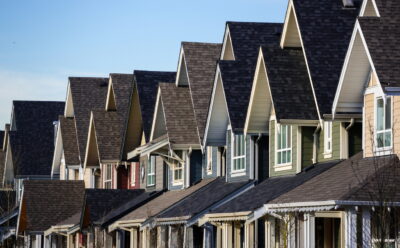At the annual general meeting in March of Ottawa’s housing association, a changing of the guard saw David Renfroe of Renfroe Land Management finish his term as president and industry veteran Pat Daniels of Glenview Homes begin his two-year post at the helm.
Following two years on the executive team as first vice-president and a further two years as second vice-president, Daniels picks up where Renfroe left off to continue the work on several important files that the Greater Ottawa Home Builders’ Association (GOHBA) is pursuing — things like the province’s bills 109 and 23 (the More Homes for Everyone Act and the More Homes Built Faster Act, respectively, both of which include measures designed to speed up housing construction), Ottawa’s Official Plan and High Performance Development Standards, and amalgamating the building code.
Daniels’ building industry background will be invaluable as he oversees the changes that are coming. But he also expects to lean on his predecessor and his executive team where needed.
He came into the industry as an architectural technologist, spending most of his career working for production builders such as Richcraft Homes, Brigil, Valecraft Homes, Tartan Homes, Urbandale Construction and others, starting as an estimator and project manager and moving up to construction management. He is currently Glenview Homes’ general manager of construction operations.
In an interview with All Things Homes, Daniels shares his goals for his term and the challenges — and opportunities — ahead.
Edited for length and clarity.
What has demanded your attention in the early days of your term?
The High Performance Development Standards have been a big topic of discussion with the City of Ottawa. And then Bill 109 and Bill 23 and their impact from the provincial to the municipal level, the city’s transportation master plan, and the Official Plan that we’re still trying to get in place, which is delaying some of those bills to fully get through.
The big one that is really in my wheelhouse is the amalgamation of the Ontario Building Code into the National Building Code (NBC) instead of having a provincial one, which we’ve had forever. The focus for us in Ontario is the energy part of things because the Ontario Building Code had a huge advantage with efficiencies in code and that is being possibly removed. The NBC is not as detailed, not as user-friendly and Ontario may fall under a different tier because it is a different code.
So, it’s been a lot to start.
Is the building code amalgamation a good thing for Ottawa or does it set us back?
It depends how it rolls out. It’s a good thing for manufacturers that there’s only one building code in Canada so that it’s all standard. Where it sets us back is that Ontario builds more than 50 per cent of Canada’s homes and we only have the say of one person representing us, so our needs versus the needs of somebody in Nova Scotia gets the same level of representation, which is not really fair to Ontario.
For the energy part of things, it’s not that we’re going to go backwards, it’s just how do we get filtered into this new code? There’s going to be some learning curves.
What are the High Performance Development Standards and what is the issue with them?
We have no issue at all with wanting the City of Ottawa to be better than other cities; the issue we have is the implementation. They’re trying to bring forward a way to make the City of Ottawa build X number or percentage of homes better than code, so regarding Net Zero Ready by 2030, they want to speed that up at the city.
The problem with it from an industry standard is they’re asking for it at an early stage of the process, at a planning stage where planners don’t really care about what the performance of the houses are. They don’t plan for that; they plan for how many houses they can get on a piece of land and where those houses can go. So, if you’re going to do that at that stage, it takes time; you’re going to have to hire another consultant, where there’s already 44 reports that you need to do a site plan or a plan of subdivision, so it will get onerous for people who really understand construction.
So, that’s the big fight with the city — to try to see how we can implement this. And with the bills that just came out to try to speed up the process at the planning and permit stage, this would bog down that system more than it already is.
What are your goals and visions for your term? What’s the top priority?
Every president who comes in starts with what they have and what they need to do. But one of the big things we needed to do is look at our bylaws internally because there’s been some changes there and the bylaws have not been looked at for a very long time. We’ve already started that process.
But mainly the goal is to continue pushing the advocacy on getting these houses built faster and affordably, and a more efficient way of getting to our goal of 1.5 million houses in 10 years in the province. Ottawa signed a pledge to have I think 151,000 of those, yet we’re still seeing where there’s been some inefficiencies at getting our site plans out. So, there’s still a struggle there trying to work together between us and the municipality to achieve those goals. One of the biggest goals is to have the relationship between us and the municipality to get to these goals.
Can we even hit those targets? We’ve never built that many before and certainly the demand right now is not there to build them now so, realistically, how do we meet this target?
A good question and a difficult one to understand because we’ve got polar opposites of what’s happening. We want to build 15,000 homes a year, but we can’t sell them because of other things in play — the cost of living, the cost of building a house, the uncertainty, interest rates, of course, are all big discussions. But as far as building them, one of the biggest things is if we do open that tap, are we able to do it? Could we get the 15,000? And with what the province is trying to do, they really are helping to take away that red tape to get those efficiencies so that, when the tap does open, we’re able to do those 15,000 houses. I think with these bills and if we work together with the municipalities, we definitely can get there.
As for physically building them, we’re trying to get people excited to be in the trades, get people from other places to come and do that here. It’s hand-in-hand, you can’t build 15,000 homes if you don’t have the people to build them and we’ve seen a slowdown in the number of people who are entering the trades and a lot of people retiring, so we’re looking at different ways to gain that back.
Final thoughts?
It’s a great association to be part of and it’s a great time to be part of it because there’s a lot that we can do and change. There’s a big turning point in our industry; there’s a demand there that the province has put on us that we need to fulfill and that as an industry we want to do. We need to work with all our stakeholders and move forward in getting that done. I think that’s what my presidency is going to be more about: how we implement it or will implement the province’s demand of 1.5 million houses in 10 years. And we’re the foundation. The next people are going to deal with the structure of it all. It’s exciting.





